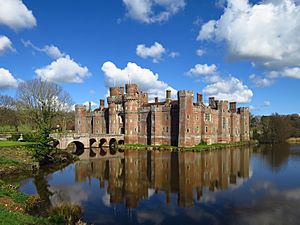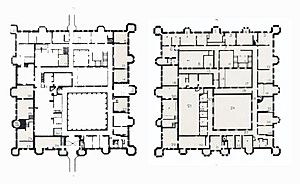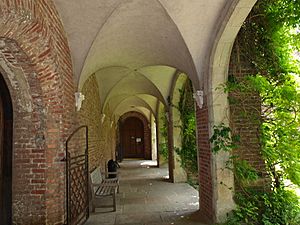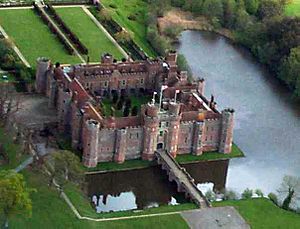Herstmonceux Castle facts for kids
Quick facts for kids Herstmonceux Castle |
|
|---|---|

Herstmonceux Castle, seen from the south-east
|
|
| Type | Medieval fortified house |
| Location | Herstmonceux |
| OS grid reference | TQ64511046 |
| Area | East Sussex |
| Built | 1441 |
| Owner | Queen's University, Canada |
| Official name: Herstmonceux Castle | |
| Reference no. | 1002298 |
|
Listed Building – Grade I
|
|
| Official name: Herstmonceux Castle with attached bridges to north and south and causeway with moat retaining walls to west | |
| Designated | 24 July 1989 |
| Reference no. | 1272785 |
| Official name: Herstmonceux Castle and Place | |
| Designated | 25 March 1987 |
| Reference no. | 1000231 |
|
Listed Building – Grade II
|
|
| Official name: Herstmonceux Science Centre | |
| Designated | 26 March 2003 |
| Reference no. | 1391813 |
| Lua error in Module:Location_map at line 420: attempt to index field 'wikibase' (a nil value). | |
Herstmonceux Castle is a beautiful brick castle from the 15th century. It is located near Herstmonceux in East Sussex, England. This castle is special because it is one of the oldest important brick buildings still standing in England.
The castle was built using bricks made from local clay. Builders from Flanders, a region in Europe, helped construct it. Building started in 1441 under its owner, Sir Roger Fiennes. His son, Lord Dacre, continued the work after Sir Roger's death in 1449.
The large parks and gardens around Herstmonceux Castle are also very important. They are listed on the Register of Historic Parks and Gardens. Other interesting places on the estate include a walled garden and the Herstmonceux Science Centre. The Science Centre has telescopes and workshops that are also historically listed.
Contents
Exploring Herstmonceux Castle's Past
How Herstmonceux Got Its Name
The first time the settlement of Herst was written about was in William the Conqueror's Domesday Book. This book, from 1086, recorded that one of William's supporters gave land at Herst to a man named Wilbert.
Later, by the end of the 1100s, the family living at the manor house in Herst became very important. Records mention a lady named Idonea de Herst. She married a nobleman from Normandy named Ingelram de Monceux. Around this time, the manor started to be called "the Herst of the Monceux." This name eventually became Herstmonceux, which we use today.
Building the Castle: A Treasurer's Dream Home
A descendant of the Monceux family, Roger Fiennes, was the person who decided to build Herstmonceux Castle. Sir Roger was the Treasurer for Henry VI of England. He needed a grand house that showed his important position.
So, in 1441, construction of the castle began on the site of the old manor house. Being the King's treasurer helped him afford the large cost of building the castle, which was about £3,800.
Changes Through the Centuries
In 1541, Sir Thomas Fiennes, Lord Dacre, faced legal trouble. After an incident during a hunting trip on a nearby estate, a gamekeeper died. Sir Thomas was found responsible and faced serious consequences. The Herstmonceux estate was taken by King Henry VIII for a while. However, it was later returned to the Fiennes family during the reign of one of Henry's children.
Later, in 1708, a descendant of the Fiennes family, the 15th Baron Dacre, had to sell the castle. He sold it to George Naylor, a lawyer from London. The castle then passed through different family members.
Eventually, Robert Hare-Naylor owned the castle. His second wife, Henrietta Henckell, convinced him to follow an architect's advice. In 1777, the castle's inside was taken apart, leaving only the outer walls standing. It became a ruin and stayed that way for many years, until the early 1900s.
Bringing the Castle Back to Life
In 1913, Colonel Claude Lowther started a big project to restore the ruined castle. He wanted to turn it back into a home. The architect Walter Godfrey designed the restoration work. Sir Paul Latham finished this work in 1933.
The inside of the castle you see today mostly dates from this time. It includes old architectural pieces from England and France. One major change was combining the four smaller courtyards inside the castle into one large one. Experts praised this restoration work as a great achievement.
Herstmonceux as a Center for Science and Learning
The Royal Greenwich Observatory's New Home
The Royal Observatory was first started by King Charles II in Greenwich in 1675. Over time, London grew, and the city lights made it harder to see the stars clearly from Greenwich. So, in the early 1900s, plans were made to move the observatory to a quieter, darker place.
In 1946, the Admiralty, which managed the Royal Observatory, bought Herstmonceux Castle and its estate. The observatory moved over ten years and was fully settled by 1957. Several new buildings were built in the castle grounds for the observatory. It was known as the Royal Greenwich Observatory until 1988, when it moved again to Cambridge.
Some of the telescopes are still at Herstmonceux. However, the biggest one, the 100-inch (254 cm) Isaac Newton Telescope, was moved to La Palma in the Canary Islands in the 1970s. The buildings that once held the telescopes are now used as an interactive science center for students. The empty dome where the Newton Telescope once stood is still there and can be seen from far away.
A University Study Center for Students
In 1992, Alfred Bader, who had studied at Queen's University in Ontario, Canada, learned that the castle was empty. He offered to buy it for his wife. She joked that it would have "too many rooms to clean" and declined.
But in 1994, after a lot of renovation work, the Queen's International Study Centre opened at the castle. It mostly hosts university students from Canada who are studying arts, science, or business. It also welcomes graduate students studying international law. Special summer programs for engineering, archaeology, and health sciences have also become popular. In 2009, the center was renamed the Bader International Study Centre. New science labs were opened recently to allow more first-year science students to attend.
Events and Historical Fun at the Castle
Herstmonceux Castle is a place where you can often see historical re-enactments. These include archers, knights, and falconers who fly their birds over the grounds. Every August, the castle hosts a large medieval weekend event. It is also a popular place for weddings and other weekend gatherings.
Herstmonceux Castle in Movies and TV
The castle has appeared in several movies and TV shows:
- It was used for filming parts of The Silver Chair in 1990. This was a BBC adaptation of the book from The Chronicles of Narnia by C. S. Lewis.
- Comedians Reeves and Mortimer used the castle and gardens for one of their funny sketches.
- In August 2002, The Coca-Cola Company rented the castle. It was part of a prize for a Harry Potter-themed contest. The castle became "Hogwarts" for a day of Harry Potter activities for the winners.
- A "painting" of the castle was used as a magical object in the U.S. TV show Charmed, in the episode "The Painted World".
Who Owned Herstmonceux Castle Through Time?
Here is a list of some of the people who owned Herstmonceux Manor or Castle:
- 1066 - Edmer, a priest.
- 1086 - Wilbert, a tenant.
- Around 1200 - Idonea de Herst (married Ingelram de Monceux).
- 1211 - Her son Waleran de Monceux.
- 1216 - His son William de Monceux.
- ? - His son Waleran de Monceux.
- 1279 - His son John de Monceux.
- 1302 - His son John de Monceux.
- 1316 - His son John de Monceux.
- 1330 - His sister Maud de Monceux (married Sir John Fiennes).
- 1351 - Her eldest son William Fiennes.
- 1359 - His son Sir William Fiennes.
- 1402 - His son Sir Roger Fiennes (who built Herstmonceux castle).
- 1449 - His son Sir Richard Fiennes (married Joan Dacre, 7th Baroness Dacre).
- 1483 - His grandson Sir Thomas Fiennes.
- 1533 - Sir Thomas Fiennes.
- 1541 - His eldest son Thomas Fiennes.
- 1553 - His brother Gregory Fiennes.
- 1594 - His sister Margaret Fiennes (married Sampson Lennard).
- 1612 - Her son Henry Lennard, 12th Baron Dacre.
- 1616 - His son Richard Leonard.
- 1630 - His son Francis Leonard.
- 1662 - His son Thomas Leonard.
- 1708 - Estate bought by George Naylor for £38,215.
- 1730 - His nephew Francis Naylor.
- 1775 - His half-brother Robert Hare, who took apart the castle in 1776.
- ? - His son Francis Hare Naylor.
- 1807 - Bought by Thomas Read Kemp.
- 1819 - Bought for John Gillon MP.
- 1846 - Bought by Herbet Barrett Curteis MP.
- ? - His son Herbert Mascall Curteis.
- ? - His son Herbert Curteis.
- 1911 - Bought by Lieutenant-Colonel Claude Lowther (who started the restoration).
- 1929 - Bought by Reginald Lawson.
- 1932 - Bought by Sir Paul Latham (who finished the restoration).
- 1946 - Bought by H.M. Admiralty for The Royal Observatory.
- 1965 - Transferred to the Science Research Council.
- 1989 - Bought by James Developments, then transferred to the Guinness Mahon Bank.
- 1993 - Bought for Queen's University, Ontario (Canada) as a gift from Drs. Alfred and Isabel Bader.
See also
 In Spanish: Castillo de Herstmonceux para niños
In Spanish: Castillo de Herstmonceux para niños







